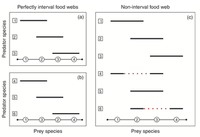
The role of body mass in diet contiguity and food-web structure
Abstract
1. The idea that species occupy distinct niches is a fundamental concept in ecology. Classically, the niche was described as an n-dimensional hypervolume where each dimension represents a biotic or abiotic characteristic. More recently, it has been hypothesised that a single dimension may be sufficient to explain the system-level organization of trophic interactions observed between species in a community. 2. Here, we test the hypothesis that species body mass is that single dimension. Specifically, we determine how the intervality of food webs ordered by body size compares to that of randomly ordered food webs. We also extend this analysis beyond the community level to the effect of body mass in explaining the diets of individual species. 3. We conclude that body mass significantly explains the ordering of species and the contiguity of diets in empirical communities. 4. At the species-specific level, we find that the degree to which body mass is a significant explanatory variable depends strongly on the phylogenetic history, suggesting that other evolutionarily conserved traits partly account for species' roles in the food web. 5. Our investigation of the role of body mass in food webs thus helps us to better understand the important features of community food-web structure and the evolutionary forces that have led us to the communities we observe.